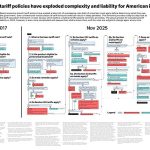
Scott Lincicome and Alfredo Carrillo Obregon
It’s a well‐known fact in the nation’s capital that politicians’ rhetoric gets progressively detached from reality as a November election approaches. During a race’s final few months, inconvenient things like “facts” and “logic” tend to get thrown out the window as candidates get desperate for votes.
On trade, at least, it seems President Biden has kicked off the 2024 “silly season” more than a year early.
In particular, Biden’s recent proclamation announcing World Trade Week 2023 (and implicitly justifying his tariff‐ and subsidy‐heavy “worker‐centric” trade policy) stated that, “For decades, the middle class and thriving towns across America were hollowed out as good‐paying jobs moved overseas and factories at home closed down.” Were this claim in the middle of an early‐autumn stump speech—from Biden or former President Trump—we may have given it a pass. But since the claim comes in the middle of a World Trade Week proclamation from the sitting president of the United States, we feel compelled to correct the record.
First, the only “hollowing out” of the American middle class over the last few decades has been due to U.S. households moving up the income ladder, not down. For example, Census Bureau data show that between 1990 and 2019—the era of “peak globalization”—the share of middle‐ and low‐income U.S. households (adjusted for inflation) have both declined, while the share of U.S. households annually earning $100,000 has increased (see Figure 1). Research on individuals’ wages shows much of the same thing.
Wage and income gains have been solid for lower‐income Americans over this same period. The Congressional Budget Office, for example, finds a 55 percent increase in the inflation‐adjusted incomes of U.S. households in the bottom 20 percent. These improvements would be even larger after accounting for taxes and transfers. (As noted in the introduction of the new Cato Institute book, Empowering the New American Worker, household income gains are likely not owed to a substantial increase in two‐earner families since 1990.) According to the most recent calculations from economist Michael Strain, moreover, inflation‐adjusted wages increased between 1990 and 2022 by 50, 48, 38, and 39 percent at the 10th, 20th, 30th, and 50th (median) percentiles, respectively (see Figure 2).
Second, while it is undeniably true that the United States has fewer manufacturing workers today than in the 1970s or 1980s and that most jobs (even male‐dominated, blue‐collar ones) are in services, American industrial jobs have not all been “shipped overseas.” As explained in a 2022 Cato paper, globalization undoubtedly eliminated some U.S. manufacturing jobs, especially labor‐intensive, low‐wage industries like textiles/apparel and furniture, but the main, long‐term drivers of U.S. manufacturing job‐losses are productivity gains and a shift in U.S. consumption from goods to services. Thus, countries around the world—including ones with large and persistent trade surpluses and active industrial and labor policies—have experienced their own, if not larger, declines in manufacturing jobs, and recent increases in U.S. manufacturing jobs have been accompanied by stagnating U.S. manufacturing productivity.
Furthermore, as explained in Empowering, there are still manufacturing jobs available in the United States—for those who want and can qualify for them:
Contrary to the conventional wisdom…, the current U.S. manufacturing job situation is not due to a lack of demand for these workers (caused by globalization or automation, for example): in the first quarter of 2022, there were around 850,000 unfilled manufacturing job openings, and new research from Deloitte and the Manufacturing Institute estimates that this figure could hit 2.1 million by 2030.
A year later, even after a significant cooling of the U.S. manufacturing sector, job openings there are historically elevated.
Third, President Biden ignores, as we explained in a 2022 paper, the tens of millions of American jobs in services and in manufacturing that are today dependent on trade and globalization:
[A] 2020 report found that trade—imports and exports—directly or indirectly supported approximately 40.6 million jobs in both goods‐producing industries (agriculture, construction, manufacturing, etc.) or services‐producing industries (wholesale/retail trade, transportation, professional services, etc.). Imports alone support an estimated 17.3 million American jobs in transportation, logistics, wholesale and retail trade, and other services industries, which comprise more than 10 percent of total employment in the sector. And almost half of all dollars spent on imported goods go to American workers rather than to the foreigners producing the goods. Thus, new research finds that, while only 6 percent of U.S. firms in manufacturing and services are goods traders, these firms account for half of economy‐wide employment today and supported 60 percent of all new net jobs created after 2008, primarily through the establishment of new businesses. [See Figure 3.]
Meanwhile, foreign direct investment supported approximately 8 million jobs in 2019. By contrast, these same American workers are harmed by protectionism: higher input costs, for example, typically mean reduced wages or unemployment in the consuming company or industry at issue.
Surely, not every American worker has come out ahead since the United States became more integrated into the global economy, but—even leaving aside the important consumption benefits that globalization has provided all Americans (even ones who lost jobs from import competition)—the narrative of broad, trade‐driven declines in middle class jobs and lifestyles is simply false. As the Financial Times’ Martin Wolf put it in April (citing the latest academic research), “contrary to the widespread view, it is untrue that liberal trade is a dominant or even significant cause of the woes of the working classes of western societies.” Indeed.
Finally, similar conclusions may be drawn regarding American communities—including ones once dependent on manufacturing. For example, a 2018 Brookings Institution report found that 115 of the 185 countries that had a disproportionate share (20 percent or more) of manufacturing jobs in 1970 had successfully transitioned away from manufacturing by 2016. Of the remaining 70 “older industrial cities”, 40 had exhibited “strong” or “emerging” (above‐average) economic performance over the same period. Thus, by 2016 almost 85 percent of American communities once dependent on manufacturing—and thus potentially “hollowed out” by new import competition—had moved or were moving beyond their industrial past. That a handful of U.S. “mill towns” hadn’t adjusted in more than four decades reveals other (and deeper) problems than simply exposure to the modern global economy. For example:
Anecdotal evidence supports these conclusions. Former textile town Greenville, South Carolina is (along with its next door neighbor Spartanburg) today a bustling metro area with a diverse economy—including several multinational manufacturers. Just up the interstate, Hickory, North Carolina—a former textile and furniture hub that was the poster‐child for the persistent ravages of the so‐called “China Shock”—has just been named by U.S. News and World Report as the “best affordable place to live in the United States” for 2023–24. (Speaking of the China Shock, the authors of those influential studies have since acknowledged that, once you consider the substantial consumer gains from China trade, just 82 of 722 U.S. commuting zones, representing 6.3 percent of the U.S. population, would experience net welfare losses. Other scholars, of course, challenge the China Shock approach and conclusions more broadly.)
For Hickory, the USNWR highlights that manufacturing continues to account for most of the area’s jobs, yet “the industry is [now] diversified, with plastics, biotechnology and pharmaceuticals playing a bigger role.” Moreover, Google and Apple have established data centers in the area, and service‐sector businesses are growing. Recognizing the area’s potential, Appalachian State University will open a Hickory‐based campus this August.
Coming in second on the same USNWR list is former steel town Youngstown, Ohio, which is “in the midst of a cultural and economic renaissance” driven mainly by service‐sector businesses.
So much for being “hollowed out.”
None of this means, of course, that certain American communities and workers don’t face real challenges in today’s globalized world. But alleging that trade caused these ills not only ignores the gains that the vast majority of Americans have experienced since the United States opened to the world decades ago, but also distracts from—as Empowering details—“the panoply of federal, state, and local policies that distort markets and thereby raise the cost of health care, childcare, housing, and other necessities; lower workers’ total compensation; inhibit their employment, personal improvement, and mobility; and deny them the lives and careers that they actually want (as opposed to the ones DC policymakers think they should want).”
Blaming trade for these and other policies’ failures might make for a good campaign soundbite, but that doesn’t make it any less silly — especially during World Trade Week.





